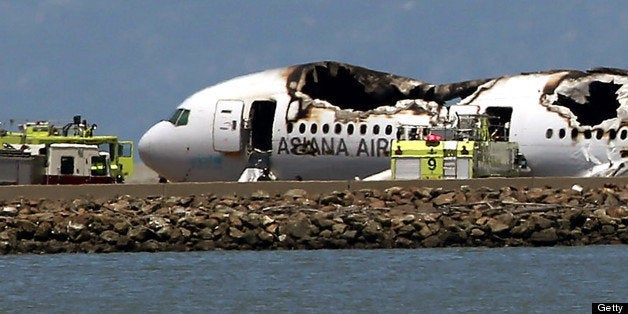
By Sarah McBride and Alistair Barr
SAN FRANCISCO, July 6 (Reuters) - An Asiana Airlines Boeing 777 with more than 300 people on board crashed on landing at San Francisco International Airport on Saturday after a flight from Seoul and burst into flames, and initial reports said two people were killed and over 70 injured.
Pictures taken immediately after the crash showed passengers streaming off the plane. TV footage from the air later showed the badly damaged fuselage of the Boeing 777 blackened by fire and the plane's tail broken off.
The airline said the plane had carried 291 passengers and 16 crew members.
The crash occurred as the plane was landing at a runway that began at the edge of San Francisco Bay. TV news footage showed crash debris right at the start of the landing strip where it met the water.
One survivor said the plane appeared to be coming in too low over the water, and the pilot seemed to be trying to gain height just before the aircraft struck the runway.
A city Fire Department dispatcher said two people were reported killed and between 73 and 103 had injuries, most of them minor. South Korean Deputy Consul General Hong Sungwook in San Francisco told Reuters at the scene one person had died and between 20 and 30 were injured.
Rachael Kagan, a spokeswoman for San Francisco General Hospital, said 15 injured people were being treated there and 10 were in critical condition with burns, fractures and internal injuries. She said most of them spoke only Korean.
She said a total of 270 people had been given some form of medical treatment at the scene of the crash and 75 had been transported to area hospitals.
AIRCRAFT'S TAIL BROKE OFF
Images on television station KTVU in San Francisco showed emergency chutes had been deployed from at least two of the aircraft's exits. Fire had burned through the cabin's roof and appeared to have gutted much of the aircraft's interior.
The plane lost its tail in the crash and parts of it could be seen near the start of the runway.
Survivor Benjamin Levy told local a local NBC station by phone that he believed the plane had been coming in too low.
"I know the airport pretty well, so I realized the guy was a bit too low, too fast, and somehow he was not going to hit the runway on time, so he was too low ... he put some gas and tried to go up again," he said.
"But it was too late, so we hit the runway pretty bad, and then we started going up in the air again, and then landed again, pretty hard," Levy said.
He said he opened an emergency door and ushered people out. "We got pretty much everyone in the back section of the plane out," he said. "When we got out there was some smoke. There was no fire then, the fire came afterward."
AIR TRAFFIC HALTED
Ying Kong, of Albany, New York, who was waiting at the airport for her brother-in-law, Fawen Yan, 47, from Richmond, California, said he telephoned her after surviving the crash to say it had been "really smoky and scary."
"He feels it difficult to breathe, but he's okay," she said. She added: "He said a lot of people had to run. He said some people got hurt."
Air traffic at the airport was halted immediately after the crash, which took place under sunny skies with only a slight breeze, but flights resumed on two runways several hours later.
The Asiana flight departed from Seoul at 5:04 p.m. Korean time and touched down in San Francisco at 11:28 a.m PDT, according to FlightAware, a website that tracks flights. The flight lasted 10 hours and 23 minutes, it said.
Deborah Hersman, chairman of the National Transportation Safety Board, said the agency was sending a team of investigators to San Francisco and that it is too early to determine the cause of the crash.
"We will be looking at everything," she told reporters. "Everything is on the table. We have to gather the facts before we reach any conclusions."
She was speaking at Reagan National Airport in Arlington, Virginia, outside Washington.
The FAA spokeswoman Laura Brown said her agency was also sending investigators.
Boeing expressed concern for those on board the flight and added that it will provide technical assistance to the NTSB as it investigates the accident.
